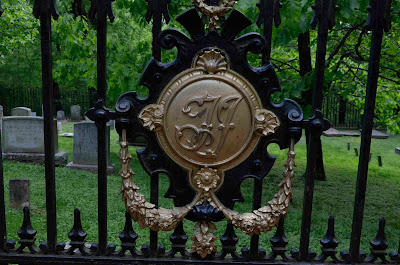During the tour, thunder and lightening drove everyone to shelter. The docents are very protective of the public during storms. Monticello is on a mountain top and, in such a storm, the mountain has to be evacuated. Basically, everyone has to go into the storage rooms or down to the visitors center.
On the Garden Tour where we learned about Jefferson’s belief that gardening is “the art of embellishing nature by fancy.” It was one of his passions. He was influenced by his time in England and France.
While at Monticello, Jefferson was Governor of Virginia and a representative. He left the home to be Secretary of State, Minister to France, Vice-President and President, which he called a “splendid misery.” When he was 66, he returned to his plantation for the rest of his life.
He was constantly recording plant growth and production. He introduced trees, decorative plants and vegetable plants to his gardens. He experimented with 330 varieties of seeds in vegetable garden keeping careful records of growth, output, and plant health. He had his slaves level an area 50 feet wide and a thousand feet long for his vegetable gardens.
In keeping with his interest in gardening, he recorded the weather daily and had several thermometers in the house and work areas.
The Slavery Tour presented the paradox between Jefferson’s words and his life. Twenty percent of the population of country were slaves by the time he was born. He had 800 slaves on his various properties, including 100 on Mulberry Road at Monticello and 15 in the house.
He talked about the end of slavery, said he would free his slaves and, yet, depended upon them for everything from the building of his home, cooking his French cuisine, growing his crops and being his vital assistants in his many innovations.
Slaves were everywhere but unseen. The household slave work rooms were built into the side of the hill under house. On Mulberry Road were the workshops and some shacks where the skilled worked and lived. Young slaves worked until age ten. If they showed good ability, they would then be trained in needed skills, otherwise they went “into the ground,” where they worked from sunrise to sunset and lived in the fields. All were provided with minimal food and clothing. To supplement their “income” many raised chickens for eggs and meat to sell. They had to do this on their own time and kept 1/6 the income. Women were more valuable than men because they bore children therefore more slaves.
This is the remains of one of the slave houses and its interior that lined Mulberry Road.
While less cruel than many slaveholders, Jefferson beat and sold “down South” a skilled slave who had escaped and been recaptured two times.
His most trusted and valuable slave was John Hemings, whose wife was the daughter of his father-in-law. Hemings was a skilled wood worker, advisor on the construction of the house, and the father of Sally Hemings. Hemings built most of the furniture in Monticello and did all of the finish woodwork in the house. These joinery exhibits were in the museum of the house. Again, all of the joinery was done by hand as there were no power tools to help with the work.
This chimney is the remains of the Joinery Building where Hemings worked.
After his wife Martha died, Jefferson fathered four children with Sally. Being 3/4 white, two of the children moved to the Northeast and melded into the general population, the other two moved to Ohio and lived in black communities. One of those relocated to Wisconsin identifying as white and went to the university. Sally was “given her time” (laid off because of her age) rather than actually freed.
After Jefferson died, Hemings was one of five slaves freed in his will. He had to work to buy his own wife and most of his children.
Jefferson believed education and reason led to self-government. He kept slaves but thought the institution should end for the benefit of the country. He was a brilliant and complex man who left a great legacy. The Jefferson Foundation has collected information on Jefferson’s life post-Presidency from family records, his own writing, and historic interviews with four former slaves.
The Jefferson family cemetery is near the home. Jefferson and his best friend made a deal to be buried near each other. The friend died young and is buried in the plot next to the obelisk that marks Jefferson’s plot.
It is easy to see why Jefferson found this area idyllic and wanted his home there. The whole area around Charlottesville is absolutely gorgeous, lush and green. Just to the west rises Shenandoah National Park and other ranges of the Appalachians.










No comments:
Post a Comment